Crafting a delightful and functional space for children within the confines of limited square footage can seem daunting. Yet, with innovative design strategies and a dash of creativity, small children’s rooms can be transformed into havens of fun, comfort, and imagination. This exploration delves into ingenious solutions that make the most of every square inch, presenting children’s room ideas perfect for small spaces. Prepare to be inspired by designs that prove limitations can indeed spark creativity, leading to beautifully organized and enchanting spaces where children can play, learn, and rest peacefully.
Space-Saving Sleep and Study Combo for Compact Rooms

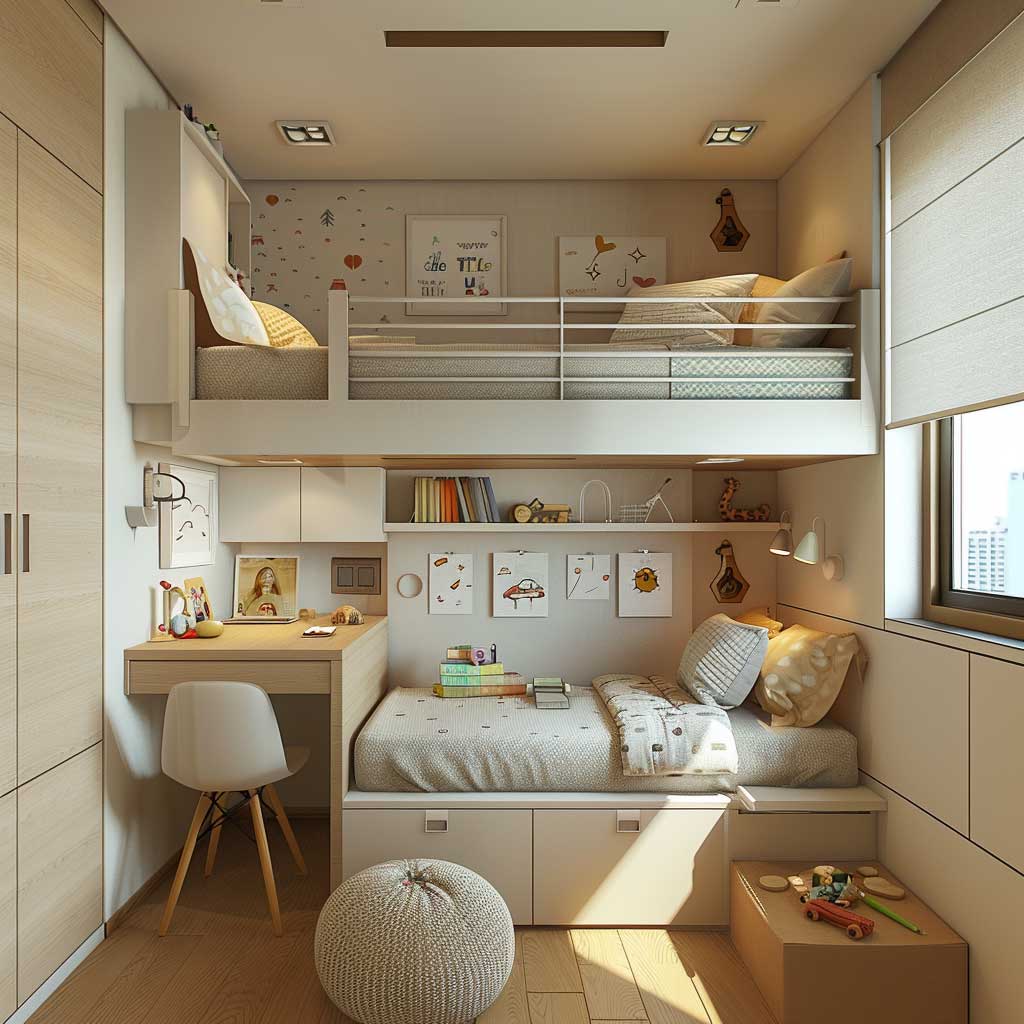

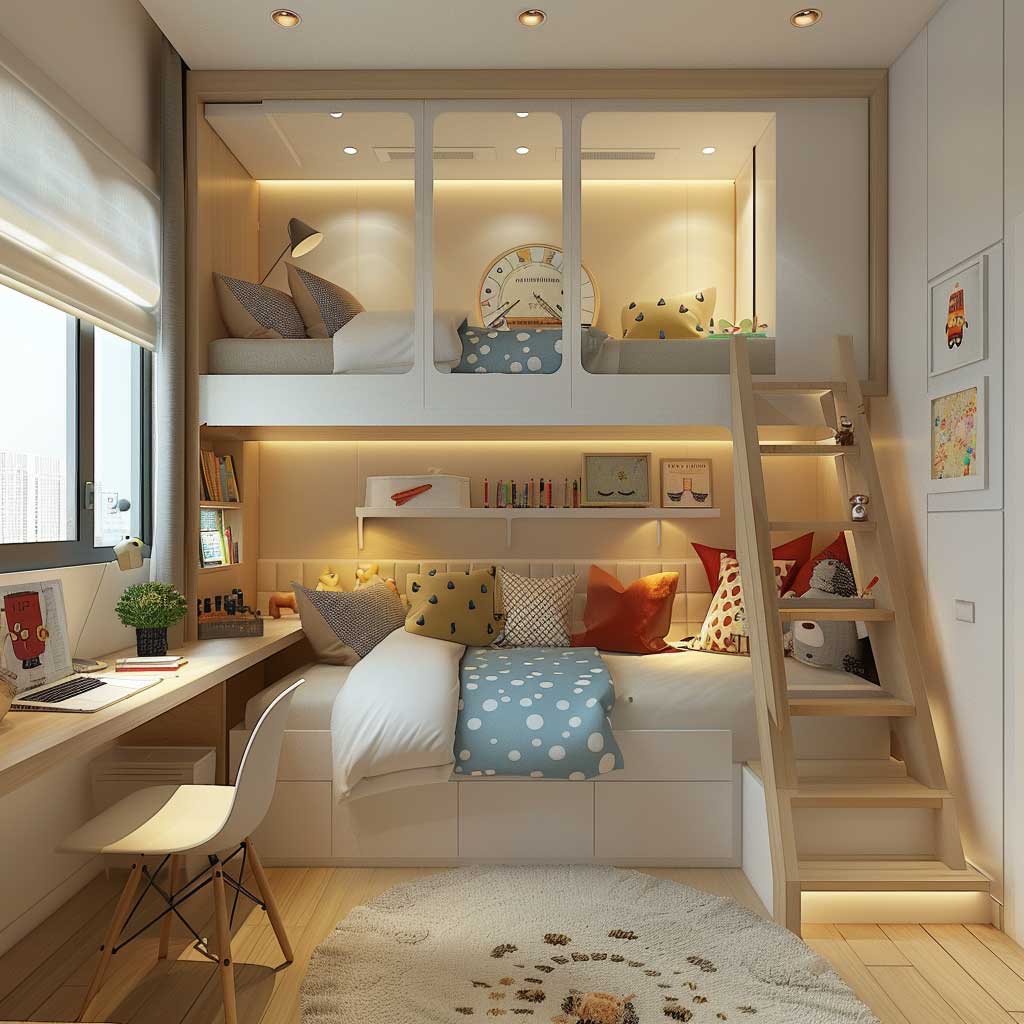
In the world of interior design, small spaces often require the most creative solutions. This is especially true when designing rooms for children, where the need for both restful sleep and a stimulating study area must coexist harmoniously. The concept of a space-saving sleep and study combo emerges as an ingenious solution to this challenge, embodying the principle that functionality and aesthetics can blend seamlessly, even in the most compact of spaces.
The essence of this design lies in its efficient use of vertical space. A loft bed, elevated above the ground, opens up the floor area traditionally occupied by a bed, creating room for a study area beneath. This arrangement not only maximizes the available square footage but also delineates clear zones for sleep and work, fostering a sense of organization and purpose in the child’s room.
Implementing a sleep and study combo requires thoughtful consideration of design elements to ensure both areas are inviting and conducive to their respective functions. The bed must be a safe, cozy retreat for rest, with guardrails for safety and easy access via a ladder or steps that are child-friendly. Incorporating playful elements, such as themed bed covers or imaginative lighting, can make the ascent to bed an adventure in itself, making bedtime more appealing to young minds.
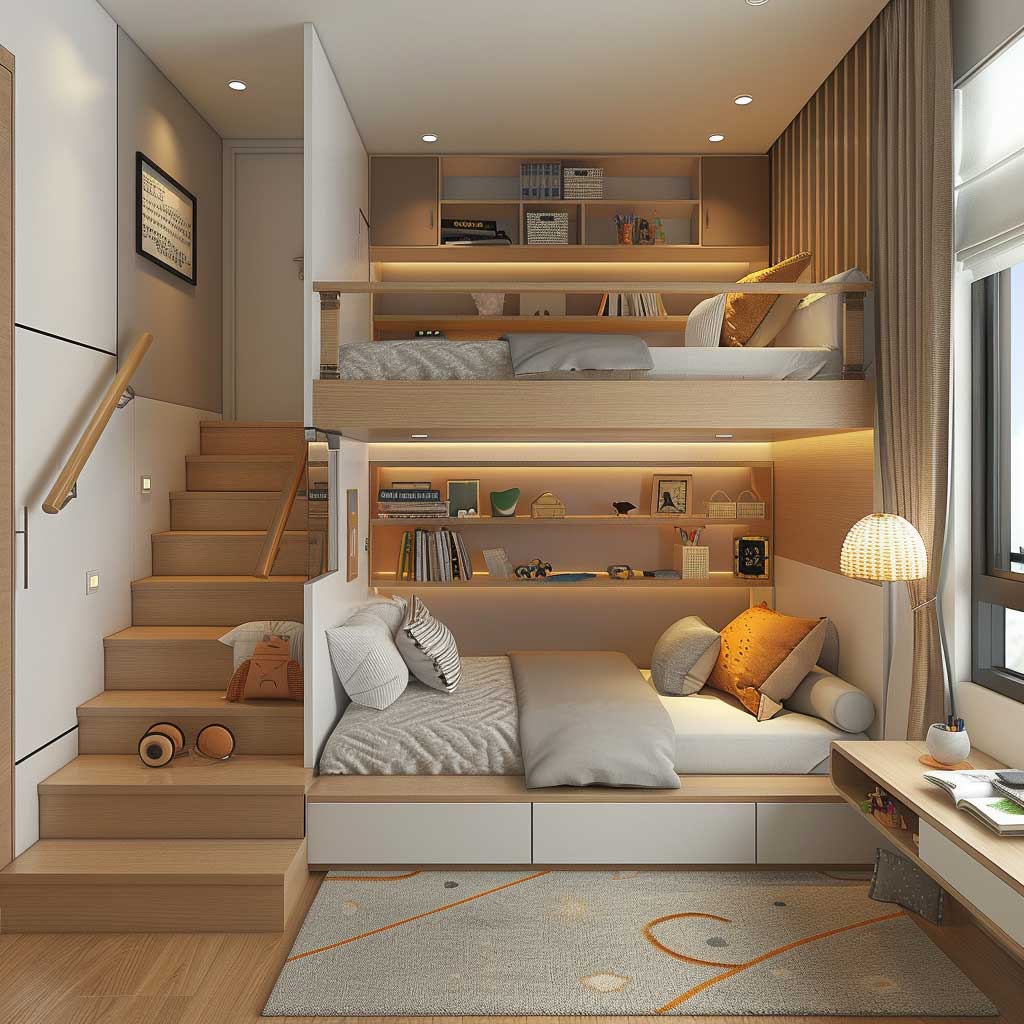

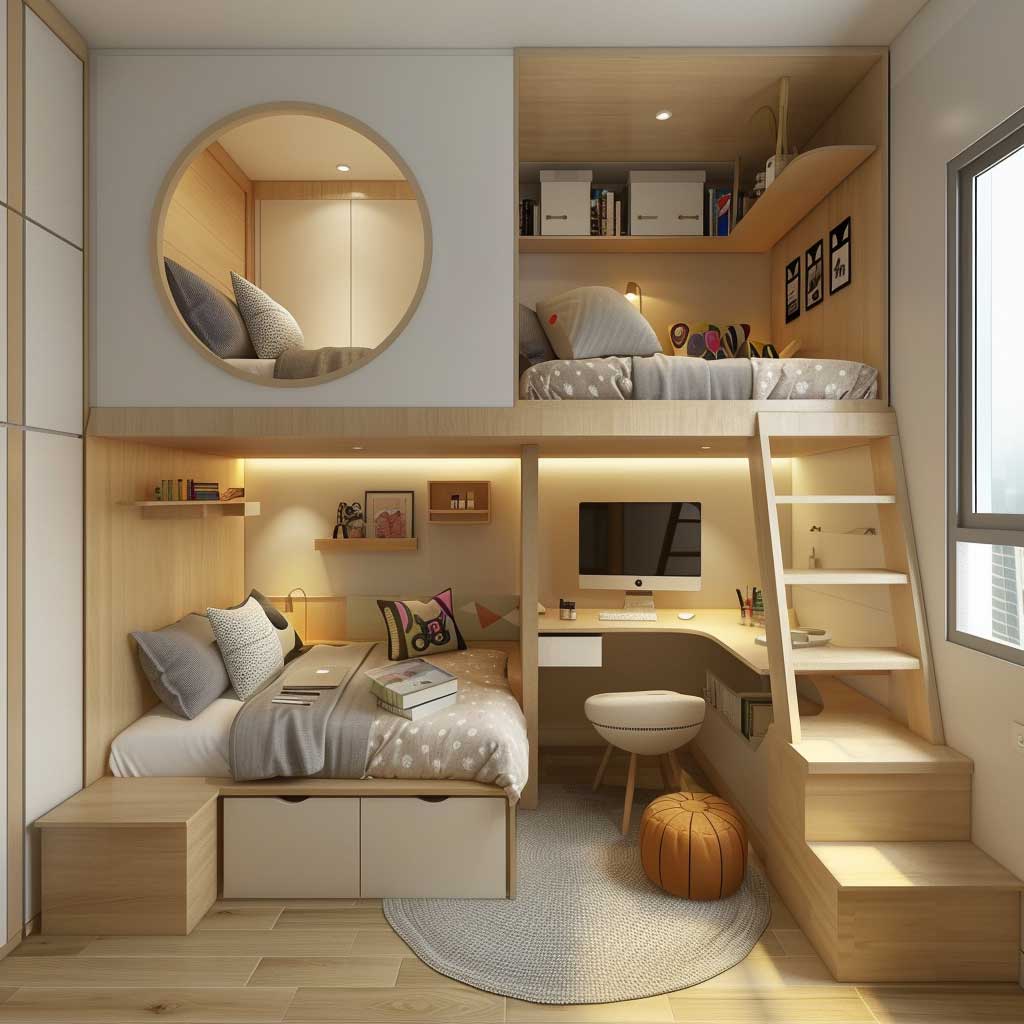

Beneath this elevated sanctuary, the study area becomes a realm of creativity and learning. A well-sized desk, ergonomic chair, and adequate lighting are fundamental components, ensuring comfort during study sessions. Storage solutions, like drawers or shelving units integrated into the desk, provide space for books, supplies, and personal items, keeping the area tidy and organized. This under-bed study zone can be personalized with vibrant colors, motivational posters, or educational tools, transforming it into a space that stimulates learning and creativity.
The beauty of a sleep and study combo in a small room lies not only in its space efficiency but also in its ability to be customized to the child’s evolving needs. As children grow, the space beneath the loft bed can transition from a study area to a lounge or hobby space, demonstrating the versatility and long-term value of this design choice.
This approach to children’s room design in small spaces represents more than just a practical solution; it’s a testament to the power of innovative thinking in overcoming spatial limitations. By elevating the bed and creating a multifunctional area below, parents can provide their children with a private oasis for both rest and intellectual engagement, even in the smallest of rooms. The space-saving sleep and study combo not only optimizes physical space but also nurtures the child’s development, offering a balanced environment where they can dream and achieve in equal measure.
Innovative Hideaway Storage Solutions in Playful Themes




In the heart of a well-designed children’s room lies the challenge of storing an ever-growing collection of toys, books, clothes, and educational materials. Small spaces, in particular, demand ingenious storage solutions that conserve space without sacrificing accessibility or aesthetic appeal. Enter the realm of innovative hideaway storage solutions, artfully integrated into playful themes that captivate and inspire young imaginations.
The magic of hideaway storage lies in its ability to blend seamlessly with the room’s decor, making the act of tidying up less of a chore and more of an adventure. For example, a bed with built-in drawers beneath the mattress can serve as a treasure chest for toys and games, while a bookcase that doubles as a secret doorway to a small reading nook encourages a love of literature and provides a cozy escape for young readers.
To further enhance the room’s functionality and charm, designers often incorporate thematic elements that reflect the child’s interests and dreams. A space-themed room, for instance, might feature a rocket ship closet that “launches” open to reveal clothing and costumes, while a jungle-inspired room could hide storage bins beneath a treehouse bed, each drawer pull shaped like a different animal.
One of the most effective strategies in creating these playful storage solutions is the use of modular and multi-purpose furniture. A desk that transforms into an art station, complete with hidden compartments for supplies, or a bench with pull-out bins labeled with fun, colorful icons, not only saves space but also encourages organization and independence.

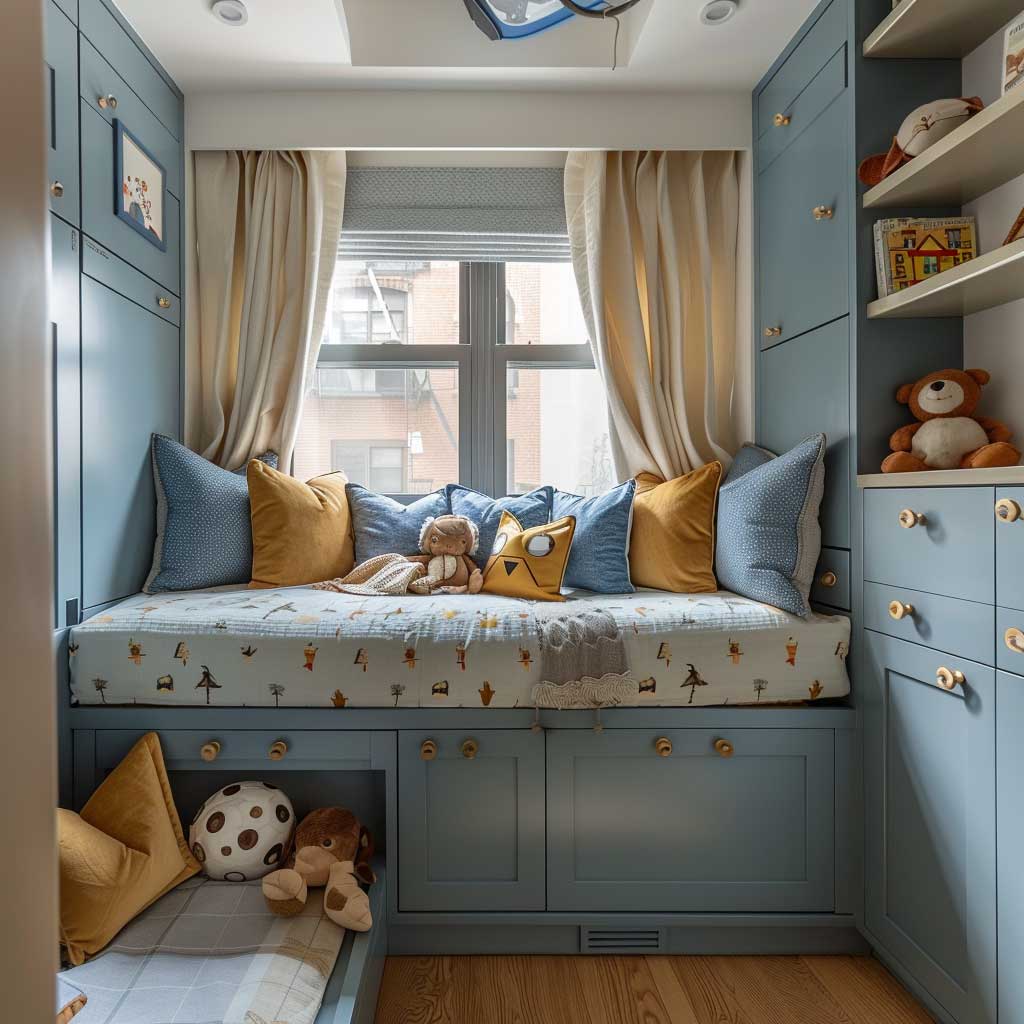


The inclusion of these themed hideaway storage solutions in a child’s room design does more than just solve the practical problem of clutter. It also plays a crucial role in stimulating the child’s imagination and sense of wonder. By integrating storage into the overall theme of the room, children are more likely to engage with their environment, seeing it as a place of discovery and creativity rather than merely a place for sleep.
Moreover, these innovative storage ideas teach children the value of organization from an early age. As they interact with the cleverly disguised storage spaces, they learn to appreciate the importance of keeping their room tidy, developing habits that will serve them well throughout life.
In crafting a children’s room where innovative hideaway storage solutions meet playful themes, designers and parents alike tap into the potential of small spaces to foster an environment that is as functional as it is enchanting. This approach not only addresses the practical needs of storage and organization but also elevates the room into a vibrant space that encourages play, learning, and growth.
In conclusion, the use of innovative hideaway storage solutions in playful themes represents a smart, engaging way to enhance the functionality and aesthetic appeal of children’s rooms, especially those with limited space. By thoughtfully integrating storage into the design, small rooms are transformed into organized, imaginative havens that children will cherish and enjoy.
Small Space, Big Imagination with Modular Play Areas




In the quest to create a versatile and imaginative play space within the confines of a small room, modularity becomes a guiding principle. Modular play areas are designed to be adaptive, providing children with the freedom to customize their environment according to the whims of their imagination. This adaptability is crucial in small spaces, where the luxury of dedicated, unchangeable play zones is often not an option.
One example of modular design in action is a foldable craft table that can be tucked away when not in use, freeing up valuable floor space for other activities. This table might transform a corner of the room into an art studio one moment and then, once folded and stored, leave open space for physical play or storytelling the next. Similarly, stackable toy bins can be reorganized or condensed as needed, allowing for easy cleanup and the flexibility to adapt the room’s layout for different types of play.
The beauty of modular play areas lies in their ability to foster both organization and creativity. By giving children the tools to reshape their play space, we empower them to take control of their environment, encouraging critical thinking and problem-solving skills. This hands-on interaction with their surroundings also promotes a sense of ownership and pride in their play area, motivating them to maintain a tidier space.




Moreover, the modular approach to design in children’s rooms for small spaces supports the idea that creativity knows no bounds. With furniture and play elements that can be easily moved, combined, and transformed, children are not just playing within their room; they are playing with their room. This dynamic interaction with their environment can lead to more imaginative play, as the limitations of space push them to think more creatively about how to use what they have available.
Incorporating modular play areas into a child’s room also allows the space to grow and change with the child. What starts as a simple play mat and toy storage can evolve into a study area with a desk and shelves, all using the same modular principles. This adaptability makes modular design a cost-effective and sustainable choice for families, as it reduces the need to completely overhaul the room with every new developmental stage or interest the child may have.
Turning a small children’s room into a multifunctional and delightful space is entirely possible with thoughtful design and smart storage solutions. By embracing innovative furniture that serves multiple purposes, utilizing hidden storage, and creating flexible play areas, parents can craft a room that feels spacious, organized, and ripe for adventure. These children’s room ideas for small spaces highlight the endless possibilities when design meets creativity, ensuring that even the coziest of rooms can offer big opportunities for fun, learning, and growth.












